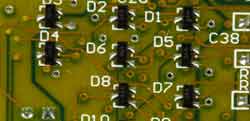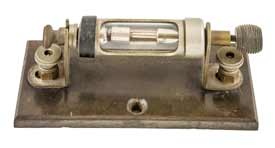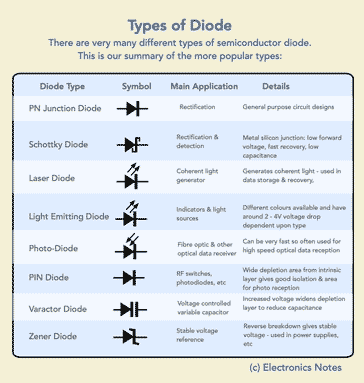Diode Types: different types of diode
There are many different diode types – not only differentiated by technology such as PN junction diodes, Schottky diodes, LEDs, varactors, SiC diodes, etc ,but there are power diodes, surface mount diodes and many more.
Home » Electronic components » this page
Diode Tutorial Includes:
Diode types
Diode specs & ratings
PN junction diode
Fast recovery diode
LED
PIN diode
Schottky barrier diode
SiC diode
Solar cell / photovoltaic diode
Varactor / varicap
Zener diode
Diode component data:
PN junction diode data
Schottky diode data
Silicon carbide, SiC Schottky diode data
The semiconductor diode is a widely used electronics component found in many electronic circuit designs today.
Although there are many different types of diode which use the same basic structure of an area of p-type material meeting an area of n-type material, the different types are optimised to provide different characteristics which can be used in a variety of ways in many electronic circuit designs.

Whatever the type of diode, the basic idea of the diode is important in the electronics industry today, whether it be used for the production of commercial or industrial equipment, of for use by the hobbyist, or anyone studying electronics.
Diodes are used in a variety of different areas. They may be for simple rectification of a signal; they may be used as power diodes for power rectification, signal detection, various forms of RF design, light generation, laser light generation, light detection and much more.
The diodes may also have a variety of different packages: surface mount diodes, normal wire leaded diodes, and some power diodes may even have the capability of being bolted to a heatsink. Diodes come in all shapes and sizes.
History of the semiconductor diode
The first diodes to be used were discovered back in the early 1900s when the technology of wireless was in its infancy. The Cat's Whisker was one of the first types diode to be used. It consisted on a very thin piece of wire (the cat's whisker itself) that could be placed onto a piece of semiconductor type material (typically a mineral crystal) to make a point contact type of diode.
This was widely used up until the middle to late 1920s when thermionic or valve technology became sufficiently cheap to be widely used for radios sets.
Around the time of the Second World War, new diodes were needed for the radar sets being developed. Semiconductor diodes provided one option as their size meant they were able to operate better at the frequencies required for radar.
Diode circuit symbol
Like all electronic components, diodes have a circuit symbol that is used within electronic circuit diagrams. The basic circuit symbol for the diode consists of a triangle with its point touching a short line perpendicular to the wire on the circuit diagram.
Sometimes the triangle and even the line are just shown in outline, whilst at other times they are shown as filled black shapes.

Sometimes the diode circuit symbol is shown only as an outline and without the filled in shapes. The outline shape is equally acceptable, although the filled type corresponds to a number of standards.

There are many different types of diode and some use circuit symbols that are slightly modified from the basic diode symbol to indicate their function: Schottky diode, varactor diode and a number of others fall into this category. For many of these the slight differences are relatively intuitive as in the case of a photo-diode, varactor or LED, whereas others like Zener and Schottky diode are less so.
Surface mount devices or leaded
Diodes come in all shapes and sizes. Traditionally many of these electronic components were contained in a small glass tube to encapsulate the actual semiconductor diode. Now diodes are contained in a whole variety of different packages.
There are still leaded packages and the glass encapsulated diodes still exist, but there are also many plastic packages as well. These can vary in size according to the power dissipation required.
With much PCB assembly these days using surface mount technology, there is a whole raft of diodes available as surface mount components, SMD diodes. There are many standard packages for SMD diodes including the SOT-23 package which is used for many small discrete diodes. Only two of the three pins available are used and this enables the diode to be correctly orientated.
As these SMD diodes are small, there is not room for the full part number to be included on the diode and short-form number are used to enable them to be distinguished.
Whilst much PCB assembly uses surface mount technology, there are other areas of the electronics manufacturing industry that need diodes with much higher current capability. These diodes can be contained within packages that bolt into heatsinks.
Types of diode
There is a host of different types of diode that are manufactured and used in a variety of electronic circuit designs, RF designs and often digital designs as well. Each type has different properties and this makes them suitable for the different circuits.
Backward diode: This type of diode is sometimes also called the back diode. Although not widely used, it is a form of PN junction diode that is very similar to the tunnel diode in its operation. It finds a few specialist applications where its particular properties can be used, typically at microwave frequencies.
A backward diode is essentially a form of tunnel diode where one side of the junction is less heavily doped than the other.
Read more about . . . . Backward diode.
BARITT diode: This form of diode gains its name from the words Barrier Injection Transit Time diode. It is used in microwave applications and bears many similarities to the more widely used IMPATT diode.
Read more about . . . . BARITT microwave diode.
Fast recovery diode: This form of diode is used where very fast switching is required along with a high reverse voltage - switching power supplies and other similar circuits use them.
Read more about . . . . Fast recovery diode.
Gunn Diode: Although not a diode in the form of a PN junction, this type of diode is a semiconductor device that has two terminals. It is generally used for generating microwave signals and has been used in many RF designs as a simple and effective form of microwave generator.
Gunn diodes are also known as transferred electron devices, or TED. Although is referred to as a diode, this electronic component does not possess a PN junction and is technically not a diode in the normal sense of the way it is used within semiconductor technology. Instead the device uses an effect known as the Gunn effect (named after the discoverer, J B Gunn).
Although the Gunn diode is normally used for generating microwave RF signals, this electronic component may also be used for an amplifier in what is sometimes called a transferred electron amplifier or TEA.
Read more about . . . . Gunn diode.
Cat's whisker: As already mentioned, this type of diode was the earliest type to gain widespread acceptance. It consisted of a small wire placed on a piece of mineral crystal. This created a small point contact diode, which although unreliable was sufficiently good to enable radio transmissions to be heard when used in a "crystal set."

Typical crystal detector / cat's whisker detector Although Cat's Whisker detectors were not particularly reliable, they were the first form of semiconductor diode and they pointed the way to later diodes . . . and the LED principle was even observed by H J Round in 1908 on one of them.
IMPATT diode: The IMPATT diode or IMPact Avalanche ionisation Transit Time microwave diode is used in a some RF designs where a simple generator is required for microwave signals.
The IMPATT diode technology not as widely used these days, but this electronic component is able to generate signals typically from about 3 and 100 GHz or more. One of the main advantages of this microwave diode is the relatively high power capability (often ten watts and more) which is much higher than many other forms of microwave diode. It has a much higher output than a Gunn diode.
Read more about . . . . IMPATT diode.
- Laser diode: This type of diode is different to the ordinary light emitting diode in that it produces laser (coherent) light. These electronic components are used in many applications including CD and DVD drives. Although much cheaper than other forms of laser generators, these diodes are more expensive than ordinary LEDs.
Read more about . . . . Laser diode.
Light emitting diodes: The light emitting diode or LED is one of the most popular types of diode. When forward biased with current flowing through the junction, light is produced. The original colour for these diodes was red, but these days most colours are available. This is achieved by using different mixes of semiconductors either side of the PN junction.
Read more about . . . . LED - light emitting diode.
Photodiode: When light strikes a PN junction it can create electrons and holes, causing a current to flow. As a result it is possible to use semiconductors to detect light. These types of diodes can also be used to generate electricity. For some applications, PIN diodes work very well as photodetectors.
Read more about . . . . Photo diode.
PIN diode: This diode type has areas of P-type and N-type silicon, but between them there is an area of intrinsic semiconductor (i.e. no doping). This increases the size of what is termed the depletion region. This type of diode is used in a number of applications including radio frequency switches and as photodiodes.
Read more about . . . . PIN diode.
Point contact diode: This type of diode performs in the same way as a simple PN junction diode, but the construction is much easier. They consist of a piece of n-type semiconductor, onto which a sharp point of a specific type of metal wire (group III metal for chemists) is placed. Some of the metal migrates into the semiconductor and produces a PN junction.
These diodes have a very low level of capacitance and are ideal for many radio frequency (RF) applications. They also have the advantage that they are very cheap to manufacture, although their performance is not particularly repeatable.
PN Junction: The standard PN junction may be thought of as the normal or standard type of diode in use today. This electronic component is incorporated into many electronic circuits designs and it is also used in many RF circuit designs as well. These diodes can come as small signal types for use in radio frequency, or other low current applications, or other types may be high current and high voltage ones that can be used for power applications.
Read more about . . . . PN junction diode.
Schottky diodes: This type of diode has a lower forward voltage drop than ordinary silicon PN junction diodes. At low currents the drop may be somewhere between 0.15 and 0.4 volts as opposed to 0.6 volts for a silicon diode.
To achieve this performance they are constructed in a different way to normal diodes having a metal to semiconductor contact. They are widely used as clamping diodes, and in RF designs, often as signal detectors. They are also used as power diodes for rectification of AC power in power supplies and the like. The lower losses caused by the smaller drop are significant in improving the efficiency.
Read more about . . . . Schottky diode.
Silicon carbide, SiC diodes: Silicon carbide is a form of semiconductor. Although well known as a very tough material used in abrasive products and other applications, it is also being used increasingly as a semiconductor where its properties enable it to provide high levels of performance in a number of areas.
The SiC dioden is a form of Schottky diode, but the reverse leakage and reverse breakdown parameters are far superior. Silicon Schottky diodes typically have a maximum reverse breakdown of 200V and many are less, but the SiC diode can have a reverse breakdown well above 1kV dependent upon the actual diode.
Read more about . . . . Silicon carbide, SiC diode.
Solar cell / photovoltaic diode: Solar cells are being used increasing as there are more applications for converting solar energy into electrical energy. Solar cells are based upon PN junction diodes and are able to convert the energy contained within light that is incident upon the diode into electrical energy. Although efficiency levels are not particularly high, the technology is improving and efficiency levels are rising.
Read more about . . . . Solar Cell / Photovoltaic Diode
Step recovery diode: A form of microwave diode used for generating and shaping pulses at very high frequencies. These diodes rely on a very fast turn off characteristic of the diode for their operation.
Read more about . . . . Step Recovery Diode, SRD.
TRAPATT diode: This type of diode has many similarities to the IMPATT and in fact it belongs to the same family. It offers lower noise, but does not reach such high frequencies.
Read more about . . . . TRAPATT diode.
- Tunnel diode: Although not widely used today, the tunnel diode was used for microwave applications where its performance exceeded that of other devices of the day.
Read more about . . . . Tunnel diode.
Varicap or varactor diodes: This type of diode is used in radio frequency (RF) applications. The diode has a reverse bias placed upon it and in this way no current flows across the junction. However the width of the depletion layer varies according to the amount of bias placed on it.
The diode can be thought of as two plates of a capacitor, with the depletion layer between them. As the capacitance varies according to the width of the depletion layer and this can be varied by changing the reverse bias on the diode, it is possible to control the capacitance of the diode.
Read more about . . . . Varactor diode.
Zener diode / voltage reference diode: The Zener diode is a very useful type of diode. It is run under reverse bias and when a certain voltage is reached it breaks down. If the current is limited through a resistor, it enables a stable voltage to be produced. This type of diode is therefore widely used to provide a reference voltage in regulated power supplies.
Read more about . . . . Zener diode.
Information sheet of popular diode types
As there are many different types of semiconductor diode, it often helps to have a summary sheet of the more widely used types.
Diodes including the basic PN junction, Schottky, LED, Varactor, Zener and more.
I've prepared a summary sheet giving the basic characteristics of each type along with the schematic symbol, applications and key details.

Click on image for larger version
There are very many different types of diode, each one suited to its own application. Not only does the technology differ between various types of diodes, but they can also be contained within different packages: some may be leaded, and others could bolt onto heatsinks and with the amount of PCB assembly that uses automated manufacturing techniques, surface mount diodes are now used in vast quantities.
 Written by Ian Poole .
Written by Ian Poole .
Experienced electronics engineer and author.
More Electronic Components:
Batteries
Capacitors
Connectors
ADC
DAC
Diodes
FET
Inductors
Memory types
Phototransistor
Quartz crystals
Relays
Resistors
RF connectors
Switches
Surface mount technology
Thyristor
Transformers
Transistor
Unijunction
Valves / Tubes
Return to Components menu . . .



